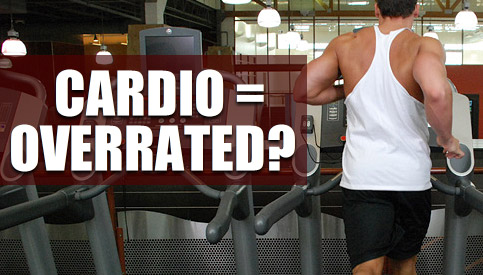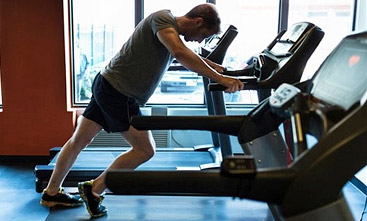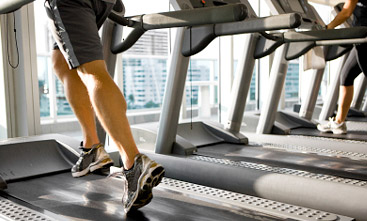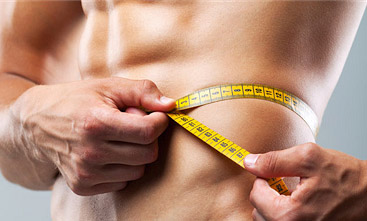IS CARDIO NECESSARY TO LOSE FAT DURING A CUTTING PHASE?

When shifting into a cutting phase in order to lose fat and get lean, there are two basic steps most trainees follow…
- They lower their calorie intake.
- They increase their cardio.
While there’s certainly a good deal of truth to the saying that “abs are made in the kitchen”, just how important is the cardio side of the equation really when it comes to losing body fat?
Is cardio necessary in order to carve out an impressively defined body, or is weight training + dieting enough on its own?
Although I do recommend that most people include some cardiovascular exercise in their programs, the simple fact is that cardio as a whole IS generally overrated as a fat loss tool.
It does provide certain benefits when performed in moderate amounts, but controlling your calorie intake is by far the most important factor if your goal is to burn off body fat consistently from week to week.
Here’s why…
Why Cardio Is Generally Overrated For Fat Loss

Before I go any further, let me make it clear that the above statement does NOT mean I’m “anti cardio” by any means.
Just because something is technically “overrated” doesn’t mean that it’s useless or that you shouldn’t do it, and performing some cardiovascular exercise during the week can produce a variety of physical and mental benefits that you likely won’t get from weight training alone.
These cardio benefits include:
- Improving cognitive function.
- Increasing levels of important mood-boosting neurotransmitters, such as serotonin and norepinephrine.
- Reducing the risk of certain diseases.
- Optimizing cardiovascular health and conditioning.
- Improving recovery in between workouts. (this benefit is specific to LISS cardio)
- Improving insulin sensitivity.
- Increasing sleep quality.
On top of these benefits, cardio of course burns additional calories to assist you in maintaining a calorie deficit for fat loss.
These benefits can be obtained by performing traditional “gym cardio” (treadmill, bike, stair stepper etc.), or by simply doing alternative forms of faster-paced exercise outside of the weight room such as sports, outdoor activities or other active hobbies.
There is no single “best cardio exercise” out there, and anything that gets your heart rate consistently elevated over a sustained period of time can count as a form of cardio.
Although some people will say that weight training can provide all of these benefits on its own, I don’t believe that a typical hypertrophy-style workout that utilizes heavier weights and longer rest periods will provide quite the same effect.
All that said, when it comes specifically to the goal of losing body fat, cardio is technically not a “must”, and it’s usually best treated as a supplemental part of your overall cutting phase rather than the main focus.
Contrary to what most beginning trainees might think, you’re not going to be rapidly melting off inch after inch of body fat as you run on the treadmill or peddle away on the stationary bike for 30-45 minutes.
Although several factors do come into play (lean body mass, workout duration, intensity etc.), the reality is that a typical cardio session doesn’t actually burn that many calories in the overall picture.
For example, if you were to follow a typical approach by performing 3 cardio workouts per week at 400 calories burned per session, that still only averages out to about 170 calories per day.
Just compare that to a few of the different food items in your typical daily diet and you’ll quickly see that 170 calories really isn’t all that much.
1 large banana contains about 120 calories… a chicken breast is around 130 calories… and two tablespoons of peanut butter provides even more than that at 200 calories.
A pound of stored body fat contains about 3500 calories, meaning you’d need to perform somewhere around 8-10 standard cardio sessions just to lose that one single pound.
And since fat loss ultimately comes down to maintaining a net calorie deficit by burning more calories than you consume in the big picture, simply moderating your calorie intake is usually a much easier and more efficient way of achieving this.
As long as your total food intake remains at a healthy level and your calories aren’t dropping excessively low, it really makes no difference from a fat burning standpoint whether you burn more calories through exercise or consume fewer calories through your diet. The net result will be the same at the end of the day.
You could raise your calorie expenditure further by increasing the duration, intensity and/or frequency of your cardio workouts, but since the benefits of cardio operate on a bell curve (to where performing too much cardio beyond a certain point becomes counterproductive), you’ll usually start running into problems if you try to do this…
3 Reasons Why Relying Too Heavily On Cardio Is A Bad Idea

Regardless of how driven and motivated you might be to get that lean and defined body you’re after, there are a few reasons why trying to speed up the process with 5+ weekly sessions on the treadmill is probably a bad idea…
1) Excessive Amounts Of Cardio Interfere With Weight Training Recovery.
Every cardio session that you perform is another stressor that you’re introducing to your body in terms of muscle damage, joint stress and overall CNS fatigue.
This is especially true of higher intensity/shorter duration HIIT style workouts which can actually be quite taxing depending on exactly how hard you’re going.
The bottom line is that you can only perform so much cardio during the week before your total training volume climbs to an excessive level and negative effects on muscle mass and strength begin kicking in.
You won’t be able to recover as effectively in between weight training workouts, and your performance on upcoming workouts will be impacted as well.
If your goal is to lose body fat while maintaining as much lean mass and strength as possible, this is something you want to avoid since weight training is by far the most important form of exercise in your program.
It’s the primary driver that allows you to both gain and maintain muscle mass, and weakening the stimulus from your workouts while you’re in a calorie deficit will make you more prone to muscle loss.
2) Cardio Increases Your Appetite.
Even though cardio does burn calories on its own, it also stimulates your body to seek out additional calories in order to replace what was lost.
The body is a very finely-tuned machine and is always aiming to strike that balance between your calorie intake vs. caloric expenditure, and performing cardio 4-5 times or more per week can very quickly lead to a large spike in appetite that may make it even more difficult to maintain a net calorie deficit.
A lot of trainees will fall into the trap of thinking that since they did their cardio for the week, all they have to do now is “eat healthy” and watch the fat fall off.
However, fat loss still ultimately comes down to burning more calories than you consume, and “healthy calories” are still calories nonetheless.
If you simply replace what you burned during your cardio session by over-eating in the hours and days after (this is one of the biggest cardio mistakes that most people make), you’re not going to make any significant fat burning progress whatsoever.
And since most people don’t truly monitor their calorie intake with a high degree of accuracy (even though they may think they do), this is very often exactly what ends up happening.
They burn an extra 200 calories per day on average through cardio… their appetite increases… they make one minor dietary choice or two that replaces those same 200 calories… and they end up right back at square one.
In more extreme cases, individuals may actually end up gaining weight despite performing large volumes of cardio throughout the week.
3) Large amounts of cardio are a significant time and energy investment.
Muscle building and fat burning results aside, the final drawback of performing marathon cardio sessions multiple days a week is the simple time and energy investment involved.
You only have a limited amount of mental and physical resources that you can utilize throughout the day and week, and chances are that fitness (hopefully) isn’t your whole life.
You probably have work or school on your plate as well, a social life and other hobbies and interests, and detracting from those aspects of your life with endless treadmill running isn’t going to be a wise usage of your effort if you don’t even truly need to be doing it in the first place.
This is especially true if cardio is something you really don’t enjoy and if it requires a lot of willpower and discipline to get done.
So, How Much Cardio Should You Do?

So, is cardio necessary to lose fat?
Technically no, but that doesn’t mean you should abandon it completely.
It’s not that “cardio is bad”; it’s simply the over-use and over-emphasis of cardio that you should be cautious with.
Exactly how much cardio is appropriate?
For most typical trainees in most situations, performing cardiovascular exercise of some kind 2-3 days per week is a good middle ground approach.
This will provide the supplemental calorie burning and physical/mental health benefits that cardio provides but without going unnecessarily overboard.
Your cardio frequency should only be increased later on if you get deeper into your cut and are trying to reach significantly low levels of body fat, since you can only cut calories from your diet for so long before your intake becomes excessively low.
When it all comes down to it though, placing your main focus on the dietary side of things is far more important when it comes to reliably losing fat from week to week.
The consistency of your cutting diet is what will ultimately make or break your results, and it’s usually a lot easier to simply shave a few calories off of your daily intake in order to create your deficit rather than trying to do it by performing huge volumes of exercise.
There’s no additional time and energy investment involved with simply eating a bit less, and you won’t even necessarily be any hungrier since cardio stimulates your appetite anyway.
Cardio can be used to supplement that calorie deficit, but moderating your calorie intake is where most of your focus should be.
“What If I Don’t Want To Do Any Cardio At All?”

The final point I’d make here is that if you truly aren’t concerned with the physical and mental health benefits of cardio… you genuinely don’t enjoy it… and your only concern is centered on losing fat while maintaining muscle… then creating your calorie deficit through your diet alone is still an option.
Cardio is not mandatory when it comes purely to fat loss, and a well-structured weight training plan in combination with a proper nutritional approach can get the job done assuming you aren’t trying to reach very low levels of body fat.
You’ll need to drop your calorie intake a bit lower in order to achieve the same result, but calories in vs. calories out is still the name of the game when it all boils down to it.
I do think that performing some cardio is a good idea as part of a balanced overall lifestyle, but every individual is different and can make that choice for themselves depending on their personal goals and preferences.
If you found this article helpful, make sure to sign up for your FREE custom fitness plan below...




